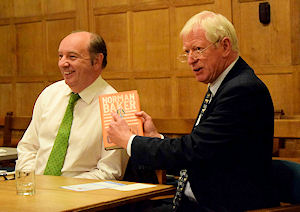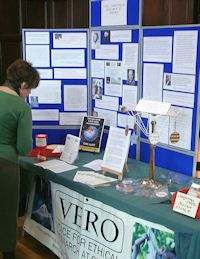NEWS AND EVENTS
Please note that news, events, and other topical matters are now reported in our blog.

19 October 2015: VERO brings Norman Baker to Oxford
 Norman Baker, the former Liberal Democrat MP and one-time Home Office
minister responsible for animal experiments, came to Oxford in the second
week of term to speak to a VERO audience on the title ‘Animal
Experiments: an Inside View from the Home Office’. The event was chaired
by VERO patron Sir David Madden.
Norman Baker, the former Liberal Democrat MP and one-time Home Office
minister responsible for animal experiments, came to Oxford in the second
week of term to speak to a VERO audience on the title ‘Animal
Experiments: an Inside View from the Home Office’. The event was chaired
by VERO patron Sir David Madden.
As Minister of State for Crime Prevention at the Home Office, Norman Baker supervised a variety of business considered to fall under that heading. For those who may have wondered what animal research was doing there – perhaps had even hoped that preventing violations of the 1986 Act was some sort of government priority – Mr Baker gave the true reason: when DEFRA was created in 2001, and given responsibility for most other aspects of animal welfare, vivisection was seen primarily as a matter of public order – i.e. a matter about which lay-people might be going to break the law – and therefore still properly Home Office business. Accordingly, whenever public order hasn’t been at issue, the subject has not been thought particularly interesting by the department’s politicians or civil servants. (Campaigners in Oxford will recognise the mind-set, since the University likewise has shown itself largely indifferent to any public concern which doesn’t require the attention of policemen or security staff.) Norman Baker’s own short period in office (2013-14) demonstrated what might be achieved if the matter were only given more purposeful and ethically-driven attention. Some of the progress made in that period has been described recently in a post on the VERO blog, which can be read here. In addition, there was some enlargement of the inspectorate which polices animal research. There was an increase in funds for the NC3Rs (the National Centre for the Replacement, Refinement and Reduction of Animals in Research), which among other things provides grants for research pioneering non-animal methods – though these funds are still pathetically small compared to those available for conventional animal research. Also, contraventions of the 1986 Act were taken more seriously: Imperial College London, for instance, was inclined to bother much less about the 2013 scandal in its laboratories than Norman Baker considered it ought to do, and he required the Registrar to resign his position as establishment licence holder for the ICL laboratories.
The attitude of the science establishment at ICL illustrates a point made by Norman Baker at the start of his talk: that there is a dangerous absence of wider moral culture in the education of scientists. Certainly there is a compulsory ‘ethics module’ in the course of training which qualifies animal-researchers to get their licences, but this is a quite inadequate corrective to a long and much too-soon specialised education which by then is already nearly completed. Anyone who has spoken on ethical matters with scientists, or read what they say, will know, not just how modest a grasp of the subject most of them seem to have, but more ominously how little they realise that.
Mr Baker was especially informative, of course, about the political necessities for progress: the need to make helpful friends across government departments or across parties; willingness to compromise; the advantage of doing things “under the radar”, or, if that proves impossible, of relating them to politically prized categories, such as ‘modern’,’world-class’, ‘competitive’, or whatever others might be in vogue at the time. It’s always easier and less risky for governments to leave things alone, if that’s possible; therefore they need convincing that intervention will bring positive credit or avert trouble. That may be why (Mr Baker said in answer to a question) Tony Blair’s administration notoriously did not honour its promise to convene a Royal Commission into the validity of animal testing: when the time came, such an inquiry probably seemed neither necessary nor likely to reward the government that sponsored it.
Norman Baker illuminated these general truths with his own experience of particular cases and particular personalities. His talk was a powerful reminder that winning the case intellectually (Peter Singer and others have often enough said that the case has indeed been won intellectually) is not enough – not enough even in universities, where one might naively expect that intelligent argument would prevail over expediency; the politics has to go right too. If that’s a disheartening reminder, given the present state of UK politics, at least Norman Baker’s own career at the Home Office has shown how much one committed individual can get done even in a short time.
11 May 2015: ‘Stop Vivisection’ Petition reaches the European Parliament
The ‘Stop Vivisection’ petition has now been debated in the European Parliament. First published in 2012, under the rules of the new European Citizens’ Initiative (ECI), the petition calls for the abrogation of Directive 2010/63/EU, which regulates animal research in the 28 member states, and an absolute end to the practice of vivisection. Having gained the signatures of over one million E.U. citizens within a year, it triggered this debate in the European Parliament. The debate took place on Monday, May 11th, at 3 p.m., and lasted for something over three hours. The text of the petition can be read here: www.stopvivisection.eu.
A full video of the debate can be seen here: www.europarl.europa.eu/news.
Here now is a summary of the debate. The petition was introduced by professors Gianni Tamino and Claude Reiss, and by Dr André Menache. They emphasised that the subject of the petition is not the ethics but the defective science of animal research. Degenerative diseases, and some other conditions, such as autism and asthma, are now very rapidly increasing. By investing in vivisection, rather than in sounder alternatives, the E.U. is failing in its duty to protect the health of its citizens.
After the introduction, three expert witnesses were invited by the Parliament to make presentations and then to answer questions and observations from M.E.Ps.
Dr Ray Greek, an expert in the history and science of the animal model in research, showed why its value, for the study of human disease and human response to therapies, is “demonstrably nil”. Then, taking a contrary view, Professor Françoise Barré-Sinoussi, who has won the Nobel Prize for her work on HIV, insisted that despite the very modest success of the search for an AIDS vaccine since the 1980s, the suffering of monkeys in that cause had been essential to it.
The third expert witness was Emily McIvor of Humane Society International, who told the Parliament that the testing of drugs and other substances constitutes only 20% of all animal research; most of the rest is “basic” research having only the most nebulous prospect of real usefulness. (One estimate, mentioned during this event, is that the proportion of basic research which eventually converts into therapeutics is 0.004%. For Ray Greek’s discussion of this figure, see the web-site opposingviews.com) The conservatism of scientists in devising such research, Ms McIvor said, needed much stronger challenging, if the E.U. Directive’s own stated objective of an end to vivisection was to be achieved.
This last point was well illustrated by something which Dr Menache said. Science and industry will find a way if absolutely required to do so. He cited the non-animal testing of Botox samples, formerly called impossible, which was made possible when the cosmetics-testing ban necessitated it. In short, the ending of vivisection would stimulate medical progress not, as is often enough claimed, terminate it.
The point most frequently made by M.E.P.s in their contributions (which were not, of course, unanimously supportive of the petition) was that the ‘Stop Vivisection’ petition was a notable and laudable achievement (only the third ECI to qualify for debate), and that it represented a most serious democratic claim on the attention of Europe’s politicians. The Directive is due for review before the end of 2017, and the review will have to show a proper and adequate response to this claim. A more immediate response to the petition is to be made by the European Commission in a few weeks’ time, from which likewise much is rightly to be expected.
So this was a very important event, not just as an intelligent and influential discussion of the scientific case against vivisection, but as showing that the case can get some real democratic purchase in European politics. Incidentally, nobody suggested during the debate that the Directive was too restrictive on scientists. For that backwards point of view, you need to come to Oxford. There was a debate at Balliol College, seven days before this European event, on the proposition “We should loosen restrictions on animal research in the U.K.” VERO knows well that there are Oxford scientists who take that view, in spite of the University’s claims to be practising a “gold standard” of animal welfare.
April 2015: Animal numbers in Oxford’s laboratories still rising
VERO learns that in spite of the University’s official commitment to the 3Rs (the principles enshrined in UK law and aimed at reducing the use of animals in science), it continues to get through animals at accelerating pace. Last year, there were 226,576 “procedures” on animals in the University’s laboratories. This represents a jump of over 19% from last year. It’s the highest number since 2007, before which year comparable statistics are not available: it may in fact be the highest annual number of animals ever sacrificed to science in the University.
The one welcome element in the statistics is that numbers of non-human primates involved in experiments has dropped from 45 in 2013 to “only” 5 last year (remember that no animal will survive its period of research). The increase has mainly been in mice and in fish, the latter being used in studies into heart malfunction. But it seems unlikely that the fall in primate numbers last year indicates a trend of any sort, because Oxford University recently announced, with some pride, a new research project in which primates will be an essential part. We therefore expect the numbers to go up again.
These numbers have been provided by the University at VERO’s request. They will not feature separately in the Home Office statistics when these are published later this year. Nor does the University publish them elsewhere, for instance on its web-site. Although its animal research web-pages now appear under the heading ‘News and Events’, no numbers more recent than 2011 are provided there, and those which are divulged are thoroughly misleading, as VERO has often enough pointed out to the University.
7 December 2014: VERO at the Oxford Green Fair
 The Green Fair brings together charities, campaign groups, businesses,
and Oxford citizens who share the ‘green’ values on which a secure future
for all living things depends. Although VERO is not a party-political
organisation, we do notice that only the Green Party offers a really
progressive policy on animals, one which includes the disuse of vivisection.
We were therefore glad to meet some of the GP’s newer leadership – including
Deputy Leader Shahrar Ali and Larry Sanders, the Party’s parliamentary
candidate for Oxford West and Abingdon – and to discuss with them the
importance of this animals policy, especially the research aspect of it, and
the part we would like it to play in the coming election. NB: ask your
Member of Parliament whether there will be an important place for animal
protection in their party manifesto!
The Green Fair brings together charities, campaign groups, businesses,
and Oxford citizens who share the ‘green’ values on which a secure future
for all living things depends. Although VERO is not a party-political
organisation, we do notice that only the Green Party offers a really
progressive policy on animals, one which includes the disuse of vivisection.
We were therefore glad to meet some of the GP’s newer leadership – including
Deputy Leader Shahrar Ali and Larry Sanders, the Party’s parliamentary
candidate for Oxford West and Abingdon – and to discuss with them the
importance of this animals policy, especially the research aspect of it, and
the part we would like it to play in the coming election. NB: ask your
Member of Parliament whether there will be an important place for animal
protection in their party manifesto!
27 August 2014: VERO patron Richard Ryder and Oxford professor Tipu Aziz on new BBC debate programme
Radio 4’s Agree to Differ aims to present topical controversies in a less personally adversarial and therefore more intelligent way. In this second episode, Dr Ryder, author of 'Victims of Science' and other publications crucial to modern animal rights, discusses the science and ethics of vivisection with Professor Aziz, a noted apologist for it who uses non-human primates in his work on Parkinson's Disease. Dr Ryder sees pain in all its forms, including fear and frustration, as the essential wrong, regardless of species. By contrast, Professor Aziz’s justification is summarized in the phrase "because we’re human". The presenter/mediator, Matthew Taylor, asserts in his summary far more agreement than the discussion really shows, but the programme is otherwise an unusually fair offering from the BBC (note, for instance, that it leads with the term 'vivisection', which practitioners do not like, rather than the euphemism 'animal research'). It’s well worth hearing, then. It lasts 45 minutes, and should be available for one year here: www.bbc.co.uk/programmes/b04fc70m.
July 2014: Experiments in UK laboratories rise again
Statistics published by the Home Office show that the numbers of licensed “procedures” on animals in the UK rose yet again in 2013, to a total of 4.12 million. Although the increase was only 0.3% (and the numbers of animals actually fell by 0.4%), that represents an extra 11,554 experiments. And it means that there has been an increase in every year but one (2009) since 2001, making a total rise of about 65% over the last thirteen years.
The main factor in this increase has been the breeding of genetically altered animals, mostly mice but including other animals (chickens, for instance – reminding us that vivisection serves the interests, inter alia, of other animal-abusive operations). GM breeding counts as a “procedure” under the 1986 Act – quite properly, since it is a physically gruesome and ethically disgusting business (see Animal Aid’s 2013 publication Science Corrupted on this subject). It’s also extremely wasteful of animal lives, and a reader of the Home Office report has to keep in mind that no national record is kept of the animals merely killed unused. Killing is not ordinarily classed as a “procedure” (why not?), and is scarcely mentioned therefore. But oddly enough it is obliquely mentioned in the very last line of the report, which states in a footnote that the wild animals “involved in rodenticide trials” are “not counted”. That prize euphemism – “involved” – is a useful reminder that this whole impressively detailed statistical compilation is itself really a giant euphemism, concealing as it does everything ugly, distressing, and wrong about its subject, except the enormous scale of it.
It is the universities and medical schools which are driving up the numbers. They have more than doubled their “procedures” since 2001, while there has been no increase at all on the part of commercial organisations (though no doubt some of the commercial research has been moved or commissioned abroad). Oxford University’s own part in this story is not, of course, specified by the Home Office. Nor do the University’s own web-pages on the subject reveal much. They give no annual totals, and although the pages have very recently been partly revised and completely re-set, the little numerical information they do provide is out of date, stopping at 2011. However, we know from other sources that “procedures” at Oxford University, after a jump of over 25% between 2011 and 2012, fell by about 7% in 2013, to the still astonishing 189,460. Although the number has been going up and down in this way for some years, as one might expect in a single institution, the trend has been firmly upward. Since the opening of the University’s Biomedical Sciences Building in 2008, there has been an increase of 45%, confirming the supposition that the building itself was a vote for vivisection.
You can read the Home Office report here.
Oxford University’s web-pages can be found here.
30 May 2014: BMJ article deconstructs animal research: "nearly impossible to rely on animal data".
Once again the scientific value of animal research is questioned, this time by an article in the leading medical journal BMJ. Written by a medical sociologist and a professor of epidemiology, the article looks at systematic reviews of the published research, and finds that bad experimental design and biased or partial reporting of results make much of this research completely unprofitable. Worse, the false promises arising from animal research will guide the next stage of research, done with human subjects, and that research will therefore very probably be wasted too.
There have been some organised efforts to improve both the practice and the monitoring of animal research, but these seem to have had very modest success, and the authors accordingly question whether this type of work, even if well conducted, really has the capacity to produce medical progress. They instance the decades of stroke research using animal models, which have failed to produce a single neuroprotective treatment for humans, and they challenge the authority and impartiality of the claims made for vivisection by its chief cheer-leader in the UK, Understanding Animal Research.
Unsound animal research is not just a waste of funds, of course; as the authors say, it betrays the public whose reluctant consent is founded on vivisection’s supposed "necessity", and it merely squanders the animals whose lives are said to be used in a good cause. This article in a peer-reviewed medical journal represents a momentous challenge to animal research. Its significance is underlined by a supportive editorial in the same issue. You can read the editorial and find further details of the article (titled 'Is animal research sufficiently evidence-based to be a cornerstone of biomedical research?') here.
Vivisection at Oxford University up nearly 30% in 2012
While experiments on animals in the UK increased by a bad enough 8% last year, Oxford University showed its continuing enthusiasm for this practice with an astonishing increase of nearly 30%, from 156,215 to 202,203. A survey by The Tab has shown that Oxford is second only to the University of Edinburgh (226,341) as a consumer of animals in its science. Most of the species were rodents, but also used and killed were pigs, badgers, ferrets, rabbits, reptiles, and non-human primates.
Important facts to note:
(a) the University does not voluntarily provide any of this information.
Its web-site (last up-dated November 2011) continues to give one number only – the much smaller and misleading number 16,000. This is the approximate number of animals alive at any given moment in its laboratories:
i.e. it’s simply the number which can be accommodated in the Biomedical Sciences Building;
(b) the number 202,203 records only the animals killed in or after experiments (they always are killed); the University apparently does not keep count of the animals which it kills unused, as surplus or unsuitable, a number that may be approximately the same again.
See more details of the Tab survey here.
7 November 2013: ‘Speciesism and Animal Research’, a talk by Richard Ryder at Mansfield College, jointly organised by VERO and Oxford Students for Animals
 Richard Ryder was a member of the ‘Oxford Group’ whose book of essays, Animals, Men and Morals: an Enquiry into the Mal-treatment of
Non-humans, launched the modern animal rights movement in 1971, and inspired Peter
Singer’s Animal Liberation (1975). Crucial to both books was Dr Ryder’s coinage ‘speciesism’, a word and
concept which – as A.C.Grayling has said – “refocused an entire debate about the relationship of humans to their fellow
animals.” In his talk, Dr Ryder spoke about this Oxford Group, and some of the people who supported its campaign, including Richard
Dawkins, Iris Murdoch, and Brigid Brophy. The remarkable successes of the movement since then have been insufficiently
acknowledged, he believes. Most importantly it has brought into being new laws to protect animals, but it has also rejuvenated the
study of philosophical ethics. Dr Ryder summarised his own contribution to that study, the theory of “painism”, which he has
written about most recently in his book Speciesism, Painism and Happiness (2011).
Richard Ryder was a member of the ‘Oxford Group’ whose book of essays, Animals, Men and Morals: an Enquiry into the Mal-treatment of
Non-humans, launched the modern animal rights movement in 1971, and inspired Peter
Singer’s Animal Liberation (1975). Crucial to both books was Dr Ryder’s coinage ‘speciesism’, a word and
concept which – as A.C.Grayling has said – “refocused an entire debate about the relationship of humans to their fellow
animals.” In his talk, Dr Ryder spoke about this Oxford Group, and some of the people who supported its campaign, including Richard
Dawkins, Iris Murdoch, and Brigid Brophy. The remarkable successes of the movement since then have been insufficiently
acknowledged, he believes. Most importantly it has brought into being new laws to protect animals, but it has also rejuvenated the
study of philosophical ethics. Dr Ryder summarised his own contribution to that study, the theory of “painism”, which he has
written about most recently in his book Speciesism, Painism and Happiness (2011).
There was a full room to hear this talk, and in answer to questions Dr Ryder gave positive and useful advice as to how the University might be re-awakened to the humanitarian tradition which he had been recalling for us.
July 2013: Home Office statistics show vivisection still increasing
Despite the Coalition Government’s original promise to “work to reduce the use of animals in scientific research”, the business of vivisection continues to grow: 4.11 million “procedures” were licensed in the UK in 2012, an increase of over 8% on 2011 and about 60% on 2000 (see Statistics of scientific procedures on living animals, Great Britain 2012). The last time that numbers of experiments exceeded 4 million was in 1982. Included in the 2012 numbers were about 2000 primates (up 22% on 2011), 4840 dogs, and 240 cats, as well as pigs, sheep, horses, deer, foxes, birds, fish, and whatever other living creatures can be forced to yield information or use. Note that Home Office statistics completely omit the much larger numbers of animals which are bred and then killed as surplus or unsuitable.
Meanwhile Oxford University, which signed a ‘Declaration on Openness on Animal Research’ in 2012, has not (at the present date) revised its own animal research web-page since November 2011 (www.ox.ac.uk/animal_research). But the numbers given there are anyway irrelevant, for they refer only to animals kept in the building (about 16000), not to the experiments in or after which animals are killed (unpublished, but about ten times as many – again not counting the animals killed unused). VERO has repeatedly invited the University to be more candid: see for instance ‘Being Open about Animal Research’ (see VERO in the Media). We believe that this habit of secrecy in a great institution is dishonest and cowardly.
27 April: 2013 World Day for Animals in Laboratories
This year the march and rally which annually commemorates the more than 110 million animals confined, experimented on, and killed in the world’s laboratories took place at Oxford, a UK centre for vivisection since the 19th Century. Campaigners assembled first in Oxpens Park - a good place to remember animals in because, as its name suggests, it was formerly the site for the city’s cattle markets. Among the speakers there was VERO’s Matthew Simpson, who spoke about the University’s ethics, past and present. Some of what he said can be heard here:
 The company of several hundred people then made the case for animals visible and audible through the main streets of Oxford,
stopping at the University’s new laboratory in Mansfield Road. With its complacent sheen and
sinister absence of doors and windows, this building is an apt monument to the science and politics of vivisection
today. There were speeches outside the laboratory from campaigner John Curtin and journalist Dr Victoria Martindale.
The company of several hundred people then made the case for animals visible and audible through the main streets of Oxford,
stopping at the University’s new laboratory in Mansfield Road. With its complacent sheen and
sinister absence of doors and windows, this building is an apt monument to the science and politics of vivisection
today. There were speeches outside the laboratory from campaigner John Curtin and journalist Dr Victoria Martindale.
12 – 13 March 2013: Oxford University Department of Zoology Conference: Rachel Carson and Ruth Harrison 50 Years on
This conference was a welcome celebration of two remarkable scientist-pioneers and their momentous
books, Silent Spring (1962) and Animal Machines (1964). The first book showed what humans were
doing to land and life, including their own, by their reckless use of half-understood herbicides and “pesticides” (whose close
but futile connection with some of the worst of vivisection persists today). The second book exposed “a new type of farming”, the
pitiless industrial farming which was then rapidly replacing traditional animal husbandry. During the conference,
 speakers from universities and environmental organisations testified to the authority and bravery of these two women, and to the
continued and tragic relevance of their books.
speakers from universities and environmental organisations testified to the authority and bravery of these two women, and to the
continued and tragic relevance of their books.
Plentiful food was provided at the conference, but no sources or details of its production were provided or apparently known. Puzzled by the disconnection between the ideals of the conference and the food put before it, VERO’s Matthew Simpson proposed that the conference pass a resolution inviting all the University’s catering committees to do what they could to apply the teachings of Rachel Carson and Ruth Harrison to the sourcing of University fare. However, the organisers did not allow this modest proposal to be formally put to the conference.
The new edition of Animal Machines includes some prefaces from specialists – among them one of the conference organisers, Oxford’s distinguished professor of animal welfare Marion Stamp Dawkins – commenting on the book’s “significant legacy and impact today”. But it seems that at Oxford itself the legacy and the impact of both books are expected to remain conveniently absent.
Previous Events
For details of previous events, see here.
